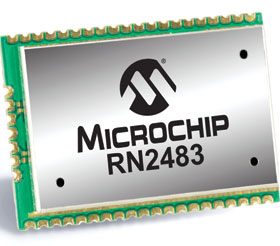

Microchip announced the first in a series of modules for the LoRa technology low-data-rate wireless networking standard, which enables Internet of Things (IoT) and machine-to-machine (M2M) wireless communication with a range of more than 16 kilometres in suburban environments, a battery life exceeding 10 years, and the ability to connect millions of wireless sensor nodes to LoRa gateways.
The 433/868 MHz RN2483 is a European R&TTE Directive Assessed Radio Module that combines a small module form factor of 17,8 x 26,3 x 3 mm with 14 GPIOs, providing the flexibility to connect and control a large number of sensors and actuators while taking up very little space.
The device comes with the LoRaWAN protocol stack, so it can easily connect with the established and rapidly expanding LoRa Alliance infrastructure, including both privately managed local area networks (LAN) and telecom-operated public networks, to create low-power wide area networks (LPWAN) with nationwide coverage.
This stack integration also enables the module to be used with any microcontroller that has a UART interface, including hundreds of Microchip’s PIC MCUs. Additionally, the RN2483 features Microchip’s simple ASCII command interface for easy configuration and control.
LoRa technology has several advantages over other wireless systems. It utilises a spread-spectrum base modulation that is capable of demodulation with a 20 dB below noise level. This enables high sensitivity with robust network links, improves network efficiency and eliminates interference.
The LoRaWAN protocol’s star topology eliminates synchronisation overhead and hops compared to mesh networks, which reduces power consumption and enables multiple concurrent applications to run on the network. LoRa technology also has a much longer range than other wireless protocols, which enables the RN2483 to operate without repeaters, reducing the total cost of ownership. In comparison to 3G and 4G cellular networks, LoRa is far more scalable and cost effective for embedded applications.
With its scalability, robust communication, mobility and the ability to operate in harsh outdoor environments, the RN2483 is well suited for a broad range of low-data-rate wireless monitoring and control designs. Additionally, it provides the ability to secure network communications using AES-128 encryption.
Example IoT and M2M applications include smart cities, such as street lights, parking and traffic sensors; energy measurement smart meters for electricity, water and gas; and industrial/commercial/home automation applications such as HVAC controls, smart appliances, security systems and lighting.
Samples of the RN2483 are available now and it is expected to be widely available for purchase in May, by which time development boards are also expected to be available, allowing designers to utilise Microchip’s free MPLAB integrated development environment.
For more information contact Shane Padayachee, Avnet South Africa, +27 (0)11 319 8600, [email protected], www.avnet.co.za

© Technews Publishing (Pty) Ltd | All Rights Reserved